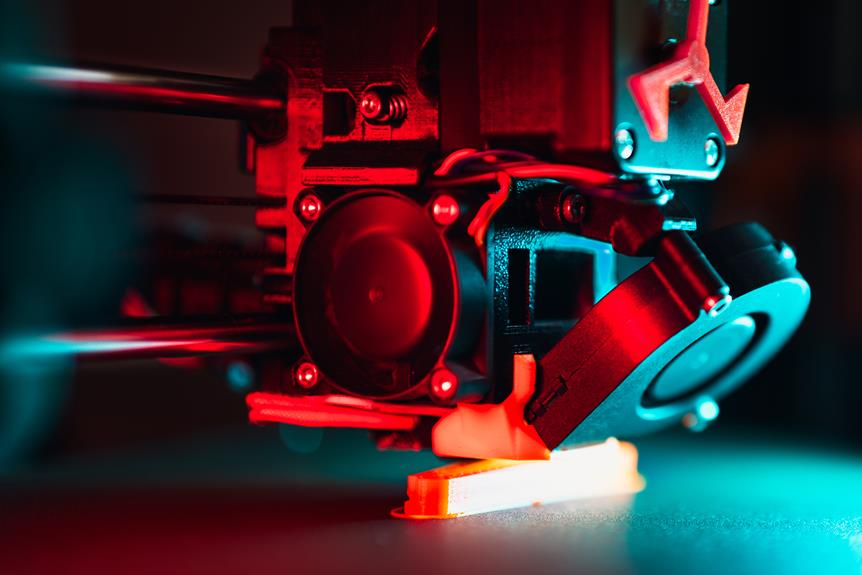Consumer-Grade Vs. Industrial 3D Printers: Making the Right Choice
In the dynamic world of 3D printing, choosing between consumer-grade and industrial printers can feel akin to navigating a vast ocean. Like a skilled sailor, one must carefully consider the currents of key features, advantages, limitations, and cost differences to chart the right course.
This article serves as a compass, guiding readers through a technical and analytical exploration of the consumer-grade versus industrial 3D printer landscape, ultimately empowering them to make an informed decision and liberate their creative potential.
Key Takeaways
- Consumer-grade 3D printers are more affordable and compact compared to industrial printers.
- Industrial 3D printers are ideal for heavy-duty and high-volume production, with the ability to print large-scale objects with high precision and accuracy.
- Industrial printers offer a wide range of material options, including metals and ceramics, while consumer-grade printers have limitations in material compatibility.
- When choosing a 3D printer, factors such as specific needs, desired precision, expertise, and cost should be considered to make an informed decision.
Key Features of Consumer-Grade 3D Printers
When considering consumer-grade 3D printers, it is important to examine their key features in order to make an informed decision. Consumer-grade 3D printers are designed for personal use and are typically more affordable and compact compared to industrial-grade printers.
One key feature to consider is the printing technology employed, such as SLA (Stereolithography) or DLP (Digital Light Processing). SLA printers use a laser to cure liquid resin, while DLP printers use a projector to solidify the resin layer by layer. Another important feature to consider is whether the printer has a dual extruder. A dual extruder allows for the simultaneous use of two different materials or colors, providing greater versatility in printing.
Consumer-grade 3D printers are often limited in terms of print size and resolution compared to their industrial counterparts. The print size of consumer-grade printers is typically smaller, ranging from a few inches to a foot, while industrial printers can accommodate larger objects. Additionally, consumer-grade printers may have a lower resolution, resulting in lower print quality and less detail compared to industrial printers.
In conclusion, when choosing a consumer-grade 3D printer, it is crucial to consider the printing technology, whether it has a dual extruder, as well as the limitations in print size and resolution. Understanding these key features will help consumers make an informed decision based on their specific needs and requirements.
Moving on, let us now explore the advantages and limitations of industrial 3D printers.
Advantages and Limitations of Industrial 3D Printers
Although industrial 3D printers have their advantages, they also come with certain limitations that need to be considered. These printers are designed for heavy-duty and high-volume production, making them ideal for industries such as aerospace, automotive, and medical.
One significant advantage of industrial 3D printers is their ability to print large-scale objects with high precision and accuracy. They can also work with a wide range of materials, including metals, ceramics, and composites, allowing for the creation of durable and functional prototypes or end-use parts. Additionally, industrial printers often have advanced features such as multiple print heads, heated build chambers, and automated part removal, which contribute to increased efficiency and productivity.
However, there are limitations to be aware of when considering industrial 3D printers. Firstly, these printers are significantly more expensive than consumer-grade printers, making them less accessible for small businesses or individuals. Additionally, the complexity of operating and maintaining industrial printers requires technical expertise and specialized training. Furthermore, the printing process can be time-consuming, especially for large objects, as it may take hours or even days to complete a single print job.
In order to make an informed decision about choosing a 3D printer, it is essential to consider various factors such as cost, materials compatibility, print volume, and required expertise. By evaluating these factors, individuals or businesses can determine whether an industrial 3D printer is the right choice for their specific needs and requirements.
Factors to Consider When Choosing a 3D Printer
One important factor to consider when choosing a 3D printer is the specific needs and requirements of the individual or business. Different printers have varying capabilities and features that cater to different applications. For example, if a business requires high precision and accuracy in their prints, they may opt for an industrial printer that offers finer resolution and more advanced material options. On the other hand, a consumer-grade printer may be sufficient for individuals who are interested in printing small, simple objects for personal use.
Another factor to consider is the size and volume of the objects that need to be printed. Industrial printers generally have larger build volumes, allowing for the production of larger parts in a single print job. Consumer-grade printers, on the other hand, often have smaller build volumes, limiting the size of objects that can be printed. Understanding the necessary scale of the prints is crucial in selecting the right printer for the job.
Furthermore, the level of expertise and technical knowledge of the user should also be taken into account. Industrial printers often require more technical know-how to operate and maintain, whereas consumer-grade printers are generally more user-friendly and require less technical expertise.
Understanding the Cost Differences Between Consumer and Industrial Printers
To fully evaluate the best 3D printer option, it is important to understand the cost differences between consumer-grade and industrial printers. Here are four key factors to consider:
- Initial investment: Industrial 3D printers often come with a higher price tag compared to consumer-grade printers. This is due to their larger build volumes, higher precision, and more advanced features. However, consumer-grade printers are generally more affordable, making them a popular choice for individuals and small businesses with limited budgets.
- Material costs: Industrial printers are designed to work with a wide range of materials, including high-performance plastics, metals, and composites. These materials tend to be more expensive than the filaments used in consumer-grade printers. Additionally, industrial printers may require specialized materials and post-processing techniques, further increasing the overall cost.
- Maintenance and repair: Industrial printers are built to withstand heavy usage and are often equipped with robust components. However, this also means that maintenance and repair costs can be higher compared to consumer-grade printers. On the other hand, consumer-grade printers may require more frequent maintenance due to their lower build quality.
- Long-term productivity: Industrial printers offer higher print speeds and larger build volumes, allowing for the production of larger and more complex objects. This increased productivity can lead to cost savings in the long run, especially for businesses that have high-volume printing needs. However, consumer-grade printers may be sufficient for individuals or businesses with lower printing requirements.
Understanding these cost differences is crucial in making an informed decision when choosing between consumer-grade and industrial 3D printers. Now let's delve into some case studies that highlight the real-world applications of these printing technologies.
Case Studies: Real-World Applications of Consumer and Industrial 3D Printing
Both consumer-grade and industrial 3D printing technologies have demonstrated their capabilities and potential through various real-world case studies. These case studies showcase the versatility and practicality of both types of printers in different industries and applications.
To provide a visual representation of these real-world applications, let's take a look at a table summarizing some notable case studies:
| Industry | Consumer-Grade 3D Printing Applications | Industrial 3D Printing Applications |
|---|---|---|
| Automotive | Prototyping of car parts | Production of custom jigs and fixtures |
| Healthcare | Creation of personalized prosthetics | Manufacturing anatomical models for surgical planning |
| Aerospace | Rapid prototyping of drone components | Printing lightweight and complex aerospace parts |
| Fashion | Design and production of custom jewelry | Manufacturing intricate textile patterns |
| Architecture | Creation of architectural models | Construction of large-scale architectural elements |
As you can see, consumer-grade 3D printers excel in prototyping and customization applications, while industrial 3D printers are capable of producing complex and functional parts at scale. These case studies highlight the diverse range of possibilities that both consumer-grade and industrial 3D printers offer, empowering industries to innovate and transform their manufacturing processes.
Frequently Asked Questions
Can Consumer-Grade 3D Printers Be Used for Industrial Applications?
Consumer-grade 3D printers are not typically suited for industrial applications due to their limited capabilities and lower quality output. Industrial 3D printers are specifically designed to meet the demands of industrial use, offering higher precision, durability, and reliability.
How Long Does It Typically Take to Print a Complex Object Using an Industrial 3D Printer?
Typically, the printing time for complex objects using an industrial 3D printer varies based on factors such as object size, complexity, and printer specifications. However, it is generally faster compared to consumer-grade printers due to their higher speed and precision capabilities.
Are Consumer-Grade 3D Printers Capable of Producing High-Quality Prints?
Consumer-grade 3D printers are capable of producing high-quality prints, but their capabilities and limitations differ from industrial 3D printers. Factors such as resolution, size, speed, and material options should be considered when choosing the appropriate printer for specific applications.
What Are Some Common Maintenance Requirements for Industrial 3D Printers?
Industrial 3D printers require regular maintenance to ensure optimal performance. Common maintenance requirements include calibrating the printer, cleaning the print bed, inspecting and replacing worn-out parts, and performing regular software updates to keep up with industry advancements.
Can Consumer-Grade 3D Printers Handle a Wide Range of Materials Like Industrial Printers?
Consumer-grade 3D printers generally have limited material compatibility compared to industrial printers. While they can handle some materials, industrial printers offer a wider range of options, including high-performance materials suitable for demanding applications.
Conclusion
In conclusion, when choosing between consumer-grade and industrial 3D printers, it is essential to consider the key features, advantages, limitations, and cost differences associated with each option.
While consumer-grade printers offer affordability and accessibility, industrial printers provide higher quality, precision, and durability.
By carefully evaluating these factors and considering real-world applications, individuals and businesses can make the right choice to meet their specific needs and achieve successful 3D printing outcomes.









